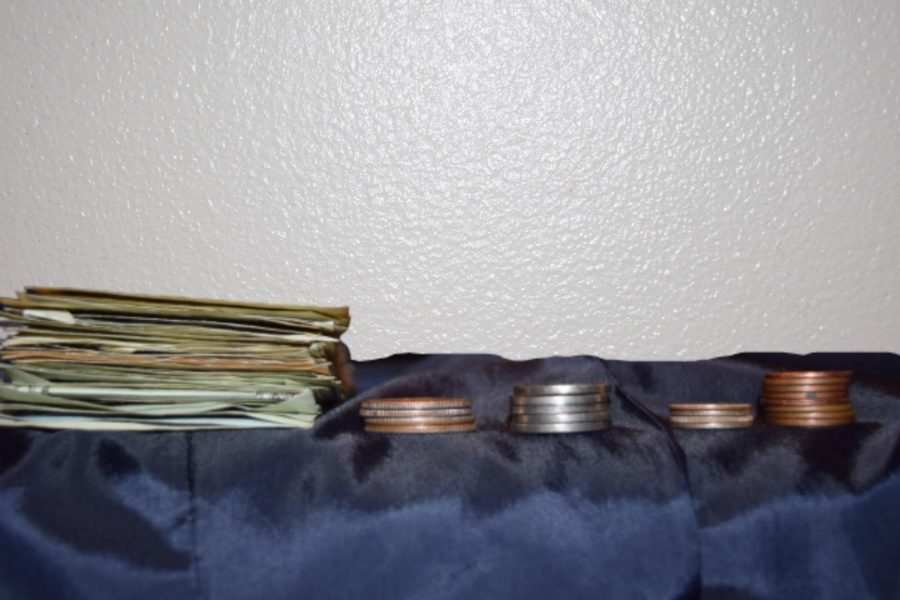Stores struggle through coin crisis
U.S. production of coins and lack of circulation creates coin shortage. Dollars are stacking up, while coins are dropping.
The United States Mint, coin processors and businesses are most accountable for putting coins into circulation daily. In late March, the West Point and San Francisco Mints temporarily shut down due to the COVID-19 pandemic. Other businesses and banks were also forced to shut down for some time. This caused the production and circulation of coins to decline as the year progressed. Americans and businesses are now faced with a national coin shortage.
There are enough coins that the U.S. Mint doesn’t need to produce extra coins to make up for an amount missing in circulation. In spite of that, the U.S. Mint is increasing production as part of the solution to the shortage. Since August, there was an increase by 0.65 billion coins produced, which is planned to continue for the rest of the year. Approximately $48 billion in coins are already being circulated, but Americans are keeping the majority of that amount within their homes. The issue will only be fixed once it is safe to go out in public and spend physical money again.
As of July 2020, the United States Mint and Federal Reserve decided to address the circulation issue by establishing the U.S. Coin Task Force. The Coin Task Force is in charge of recognizing and suggesting ways to aid the coin circulation. One of the propositions made by the group was to encourage customers to deposit coins at retail coin kiosks and financial institutions.
Quarantine for many Americans started in March. Due to the pandemic, many people have turned to shopping online to stay safe. However, this affects businesses who rely on customers paying for goods and food in person. Without customers coming into stores, the stores will have no way of receiving cash and coins. Retailers will also have no way of giving back change to customers who pay over the exact cost.
To fix this problem, many stores have switched to only accepting mobile or card payment methods. Limiting customers to only card payments is a problem for the millions of low-income Americans who don’t have a bank account. Other ways stores are countering the problem is by asking customers to bring exact change when paying, or changing their prices to whole dollar amounts. Stores are also asking customers to bring in coins in exchange for cash, food or loyalty cards. These efforts do help, but for some it isn’t enough. Alternatively, store owners have gone on trips to buy coins off of other business owners by using checks.
“I’m a cash oriented business so having to have exact change where I want to pay for stuff kinda stinks, I hate using a card. Our business is cash, so I have 50% cash, and I work with it so having to do specific change sometimes has definitely affected me personally,” owner Steve Gates of Steve and Benny’s Chicken Shack said.
Many small businesses are already suffering during these times, and the coin shortage is adding on to their stress. Smaller businesses already have to worry about reducing work hours and laying off employees because of COVID-19. They also need to figure out how to pay for all of their expenses while most customers are staying at home. Some small businesses are being forced to shut down completely because they can’t keep up a business without customers.
“Supporting small business, buying from small businesses and going out of your way to support small business I think would be the best possible answer, because it’s easy to go get food somewhere from somebody that owns a bunch of change, but the person that’s struggling is the one that owns one restaurant that has 25% occupancy. Take some more time out of your day and spend an extra couple bucks if you have it to support a small business,” Gates said.
It’s not expected that the coin shortage will carry on past the pandemic. The economy will recover as businesses start opening again. As people start to go outside more to shop, coins will go back to circulating normally. The extra production of coins by the U.S. Mint will help accelerate that circulation.
“There’s nothing that’s any cause for concern. It’s just one of those little bumps that we have in the road of going and trying different routes of being able to make it. Get out there and hit your retail stores, keep them going,” Rosenberger said.



